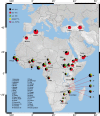Molecular diversity and population structure at the Cytochrome P450 3A5 gene in Africa
- PMID: 23641907
- PMCID: PMC3655848
- DOI: 10.1186/1471-2156-14-34
Molecular diversity and population structure at the Cytochrome P450 3A5 gene in Africa
Abstract
Background: Cytochrome P450 3A5 (CYP3A5) is an enzyme involved in the metabolism of many therapeutic drugs. CYP3A5 expression levels vary between individuals and populations, and this contributes to adverse clinical outcomes. Variable expression is largely attributed to four alleles, CYP3A5*1 (expresser allele); CYP3A5*3 (rs776746), CYP3A5*6 (rs10264272) and CYP3A5*7 (rs41303343) (low/non-expresser alleles). Little is known about CYP3A5 variability in Africa, a region with considerable genetic diversity. Here we used a multi-disciplinary approach to characterize CYP3A5 variation in geographically and ethnically diverse populations from in and around Africa, and infer the evolutionary processes that have shaped patterns of diversity in this gene. We genotyped 2538 individuals from 36 diverse populations in and around Africa for common low/non-expresser CYP3A5 alleles, and re-sequenced the CYP3A5 gene in five Ethiopian ethnic groups. We estimated the ages of low/non-expresser CYP3A5 alleles using a linked microsatellite and assuming a step-wise mutation model of evolution. Finally, we examined a hypothesis that CYP3A5 is important in salt retention adaptation by performing correlations with ecological data relating to aridity for the present day, 10,000 and 50,000 years ago.
Results: We estimate that ~43% of individuals within our African dataset express CYP3A5, which is lower than previous independent estimates for the region. We found significant intra-African variability in CYP3A5 expression phenotypes. Within Africa the highest frequencies of high-activity alleles were observed in equatorial and Niger-Congo speaking populations. Ethiopian allele frequencies were intermediate between those of other sub-Saharan African and non-African groups. Re-sequencing of CYP3A5 identified few additional variants likely to affect CYP3A5 expression. We estimate the ages of CYP3A5*3 as ~76,400 years and CYP3A5*6 as ~218,400 years. Finally we report that global CYP3A5 expression levels correlated significantly with aridity measures for 10,000 [Spearmann's Rho= -0.465, p=0.004] and 50,000 years ago [Spearmann's Rho= -0.379, p=0.02].
Conclusions: Significant intra-African diversity at the CYP3A5 gene is likely to contribute to multiple pharmacogenetic profiles across the continent. Significant correlations between CYP3A5 expression phenotypes and aridity data are consistent with a hypothesis that the enzyme is important in salt-retention adaptation.
Figures


Similar articles
-
Global pharmacogenomics: distribution of CYP3A5 polymorphisms and phenotypes in the Brazilian population.PLoS One. 2014 Jan 10;9(1):e83472. doi: 10.1371/journal.pone.0083472. eCollection 2014. PLoS One. 2014. PMID: 24427273 Free PMC article.
-
CYP3A5 polymorphisms and their effects on tacrolimus exposure in an ethnically diverse South African renal transplant population.S Afr Med J. 2020 Jan 29;110(2):159-166. doi: 10.7196/SAMJ.2020.v110i2.13969. S Afr Med J. 2020. PMID: 32657689
-
Impact of the CYP3A5*1 Allele on the Pharmacokinetics of Tacrolimus in Japanese Heart Transplant Patients.Eur J Drug Metab Pharmacokinet. 2018 Dec;43(6):665-673. doi: 10.1007/s13318-018-0478-6. Eur J Drug Metab Pharmacokinet. 2018. PMID: 29691732
-
CYP3A5 gene polymorphisms and their impact on dosage and trough concentration of tacrolimus among kidney transplant patients: a systematic review and meta-analysis.Pharmacogenomics J. 2020 Aug;20(4):553-562. doi: 10.1038/s41397-019-0144-7. Epub 2020 Jan 6. Pharmacogenomics J. 2020. PMID: 31902947
-
Pharmacogenetic biomarkers: cytochrome P450 3A5.Clin Chim Acta. 2012 Sep 8;413(17-18):1312-7. doi: 10.1016/j.cca.2011.10.013. Epub 2011 Oct 18. Clin Chim Acta. 2012. PMID: 22037511 Review.
Cited by
-
Towards Evidence-Based Implementation of Pharmacogenomics in Southern Africa: Comorbidities and Polypharmacy Profiles across Diseases.J Pers Med. 2023 Jul 26;13(8):1185. doi: 10.3390/jpm13081185. J Pers Med. 2023. PMID: 37623436 Free PMC article.
-
Worldwide Distribution of Cytochrome P450 Alleles: A Meta-analysis of Population-scale Sequencing Projects.Clin Pharmacol Ther. 2017 Oct;102(4):688-700. doi: 10.1002/cpt.690. Epub 2017 May 26. Clin Pharmacol Ther. 2017. PMID: 28378927 Free PMC article.
-
Population Genomics and the Statistical Values of Race: An Interdisciplinary Perspective on the Biological Classification of Human Populations and Implications for Clinical Genetic Epidemiological Research.Front Genet. 2016 Feb 17;7:22. doi: 10.3389/fgene.2016.00022. eCollection 2016. Front Genet. 2016. PMID: 26925096 Free PMC article. Review.
-
Warfarin Pharmacogenomics for Precision Medicine in Real-Life Clinical Practice in Southern Africa: Harnessing 73 Variants in 29 Pharmacogenes.OMICS. 2022 Jan;26(1):35-50. doi: 10.1089/omi.2021.0199. Epub 2021 Dec 24. OMICS. 2022. PMID: 34958284 Free PMC article.
-
Standardized Biogeographic Grouping System for Annotating Populations in Pharmacogenetic Research.Clin Pharmacol Ther. 2019 May;105(5):1256-1262. doi: 10.1002/cpt.1322. Epub 2019 Jan 21. Clin Pharmacol Ther. 2019. PMID: 30506572 Free PMC article.
References
-
- Coleman R. Disease burden in sub-Saharan Africa. Lancet. 1998;351(9110):1208. - PubMed
Publication types
MeSH terms
Substances
Grants and funding
LinkOut - more resources
Full Text Sources
Other Literature Sources
Molecular Biology Databases

